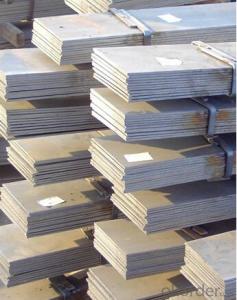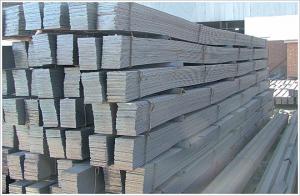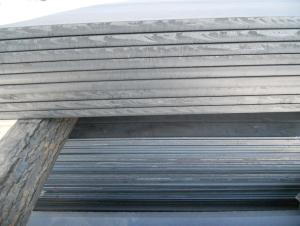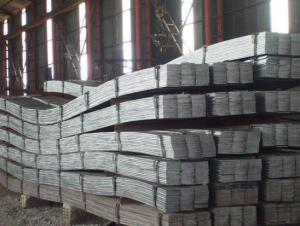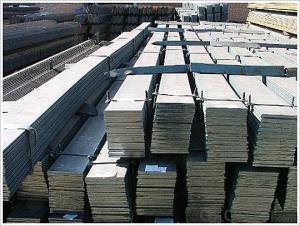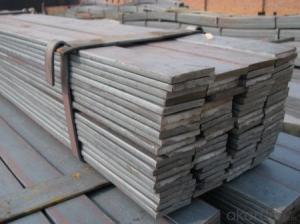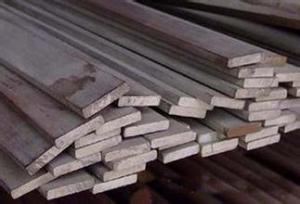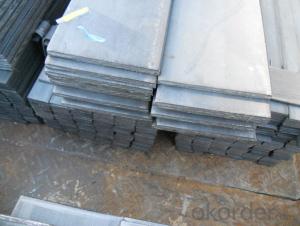Mild Carbon Steel Flat Bar
- Loading Port:
- China Main Port
- Payment Terms:
- TT or LC
- Min Order Qty:
- -
- Supply Capability:
- 10000 m.t./month
OKorder Service Pledge
OKorder Financial Service
You Might Also Like
Specification of Carbon Steel Flat Bar
Commodity: Carbon Steel Flat Bar
Standard: GB, JIS, ASTM,
Material: Q235, SS400 or Equivalent
Origin place: China
Thickness: 3mm-30mm
Width:20mm-200mm
Length: Max 12m
Certification: SGS/BV
Chemical composition of Q235
Alloy No | Grade | Element(%) | ||||
C | Mn | S | P | Si | ||
Q235 | B | 0.12—0.20 | 0.3—0.7 | ≤0.045 | ≤0.045 | ≤0.3 |
Physical properties of Q235
Alloy No | Grade | Yielding strength point(Mpa) | Tensile strength (Mpa) | Elongation after fracture(%) | ||||||
Thickness (mm) | Thickness (mm) | |||||||||
≤16 | >16--40 | >40--60 | >60--100 | ≤16 | >16--40 | >40--60 | >60--100 | |||
≥ | ≥ | |||||||||
Q235 | B | 235 | 225 | 215 | 205 | 375--500 | 26 | 25 | 24 | 23 |
Usage/Applications of Carbon Steel Flat Bar
Widely used for construction;
Machinery manufacturing;
Iron tower steel structure;
Shipbuilding; Steel grating;
Staircase;
Bridge;
Viaduct;
Railway spare parts;
Boilers making etc.
Packaging & Delivery of Carbon Steel Flat Bar
Packaging Details: The Steel Flat Bars are packed in bundles and loaded in 20 feet/40 feet container, or shipped by bulk cargo ,also we can do as customer's requirements.
Delivery Details:30~45 days upon the receipt of buyer payment by T.T. or L/C.
Production Flow of Carbon Steel Flat Bar
The Carbon Steel Flat Bar is made through three processes:
1.Feeding the material: Feeding the row material (the steel plate) to Slitting Line.
2.Slitting:The steel plate would be slitted into expected width by lengthways cutter.
3. Leveled and cutting: The plat bar would be ground into level by the grinder and then cut into required length.
FAQ:
Q1: What makes stainless steel stainless?
A1: Stainless steel must contain at least 10.5 % chromium. It is this element that reacts with the oxygen in the air to form a complex chrome-oxide surface layer that is invisible but strong enough to prevent further oxygen from "staining" (rusting) the surface. Higher levels of chromium and the addition of other alloying elements such as nickel and molybdenum enhance this surface layer and improve the corrosion resistance of the stainless material.
Q2: Can stainless steel rust?
A2: Stainless does not "rust" as you think of regular steel rusting with a red oxide on the surface that flakes off. If you see red rust it is probably due to some iron particles that have contaminated the surface of the stainless steel and it is these iron particles that are rusting. Look at the source of the rusting and see if you can remove it from the surface.
Q3: Why buy Materials & Equipment from OKorder.com?
A3: All products offered byOKorder.com are carefully selected from China's most reliable manufacturing enterprises. Through its ISO certifications, OKorder.com adheres to the highest standards and a commitment to supply chain safety and customer satisfaction.
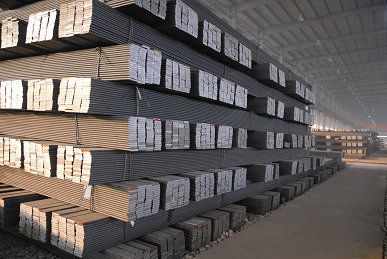
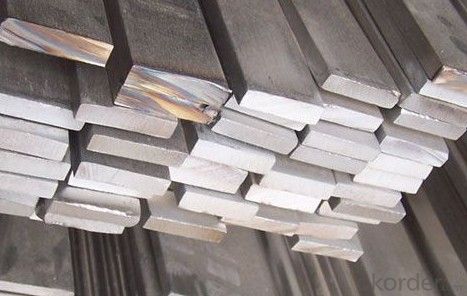
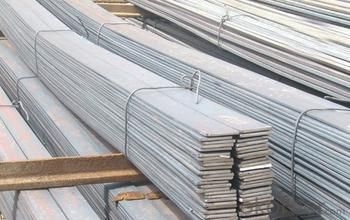
- Q: What are the different types of surface defects in steel flat bars?
- Steel flat bars can experience various surface defects, including scale, rust, pitting, surface cracks, lamination, and inclusions. Scale refers to an oxide layer that forms during manufacturing, affecting appearance and smoothness. Rust is a common defect caused by exposure to moisture or corrosive environments, weakening the bar's structural integrity. Pitting, caused by corrosion or chemical reactions, results in small cavities and reduced strength. Surface cracks, caused by manufacturing defects, mishandling, or excessive stress, compromise strength and safety. Lamination defects involve layer separation or voids due to manufacturing or improper heat treatment, weakening the bar's structure. Inclusions are foreign particles trapped during manufacturing, affecting mechanical properties. Identifying and addressing these defects is crucial for ensuring the quality, reliability, and safety of steel flat bars. Regular inspections, proper handling, and appropriate surface treatment help prevent and mitigate these issues.
- Q: What are the different types of protective coatings for steel flat bars?
- There are several types of protective coatings available for steel flat bars, including galvanization, powder coating, paint, and epoxy coatings. Each type of coating offers varying levels of protection against corrosion, abrasion, and environmental damage, allowing the steel flat bars to maintain their structural integrity and appearance over time.
- Q: How is a steel flat bar manufactured?
- Hot rolling is the method used to manufacture a steel flat bar. This involves heating a large rectangular steel billet until it becomes malleable. The billet is then passed through a series of rolling mills where it is gradually compressed and shaped into a flat bar. To begin the manufacturing process of a steel flat bar, the steel billet must be prepared. Typically made of carbon steel, the billet is cast into a rectangular shape and then reheated in a furnace to a temperature that allows for easy shaping and manipulation. Once the billet has reached the desired temperature, it is fed into a series of rolling mills. These mills consist of rollers that gradually reduce the thickness and shape of the steel billet as it passes through. The billet is subjected to immense pressure from the rollers, causing it to elongate and take on the desired flat shape. As the billet passes through the rolling mills, it is cooled and lubricated to prevent overheating and excessive wear. Cooling methods such as water or air jets are used, while lubricants like oil or emulsions are applied to reduce friction and improve the surface finish. After undergoing several passes through the rolling mills, the steel billet is transformed into a flat bar with the desired dimensions. The bar is then cut to the required length and allowed to cool. Additional processes such as straightening, surface treatment, and quality inspection may be carried out before the bar is ready to be shipped or used in various applications. In summary, the manufacturing process of a steel flat bar involves heating the steel billet, passing it through rolling mills to shape and reduce its thickness, and then cutting and cooling the bar to its final dimensions. This process ensures that the steel flat bar possesses the necessary strength, durability, and surface finish required for its intended application.
- Q: Can steel flat bars be used for making tools or hardware?
- Yes, steel flat bars can be used for making tools or hardware. Steel is a common material used in the manufacturing of various tools and hardware due to its strength, durability, and versatility. Flat bars can be easily shaped, cut, or welded to create different types of tools or hardware items such as wrenches, chisels, brackets, or supports.
- Q: Are steel flat bars suitable for making toolboxes?
- Indeed, toolboxes can be constructed using steel flat bars. Steel, being a material that is both durable and strong, is well-suited for this purpose, as it allows the toolboxes to endure heavy loads while effectively safeguarding the tools. By conveniently welding steel flat bars together, a robust and dependable structure for the toolbox can be effortlessly formed. Furthermore, the corrosion resistance of steel proves advantageous, particularly for toolboxes that may encounter moisture or harsh surroundings. In summary, the utilization of steel flat bars is a dependable and pragmatic option when crafting toolboxes.
- Q: Can steel flat bars be used in the manufacturing of tools?
- Yes, steel flat bars can be used in the manufacturing of tools. Steel is a widely used material in tool manufacturing due to its strength, durability, and versatility. Steel flat bars can be easily machined, shaped, and heat-treated to create various types of tools such as wrenches, chisels, scrapers, and cutting tools. These flat bars can be cut, drilled, and welded to form the desired tool shape, and their inherent strength allows them to withstand the forces and pressures exerted during tool use. Steel flat bars also provide good resistance to wear, ensuring that the tools can withstand repeated use without losing their functionality. Overall, steel flat bars are a reliable and commonly used material in the manufacturing of tools.
- Q: What are the different techniques for joining steel flat bars together?
- There are several techniques for joining steel flat bars together, depending on the specific requirements and applications. Some of the common techniques include welding, bolting, riveting, and adhesive bonding. 1. Welding: Welding is one of the most widely used techniques for joining steel flat bars. It involves melting the edges of the flat bars and fusing them together using heat. Different welding methods, such as arc welding, gas welding, and laser welding, can be used depending on the thickness and composition of the steel bars. 2. Bolting: Bolting is an effective technique for joining steel flat bars, especially when disassembly is required. It involves drilling holes in the flat bars and using bolts, nuts, and washers to secure them together. Bolting provides a strong and reliable connection but may require periodic maintenance to prevent loosening. 3. Riveting: Riveting involves driving a metal pin or rivet through holes drilled in the steel flat bars. The rivet is then deformed on the opposite side, creating a permanent connection. Riveting provides a strong joint and is commonly used in structural applications where high strength and rigidity are required. 4. Adhesive bonding: Adhesive bonding is a technique where a strong adhesive is applied between the surfaces of the steel flat bars to create a bond. This method is suitable for joining thin flat bars or when welding or drilling is not feasible. Adhesive bonding provides a clean and aesthetically pleasing joint but may have limitations in terms of strength and durability. 5. Mechanical fasteners: Mechanical fasteners, such as clips, clamps, or brackets, can be used to join steel flat bars together. These fasteners are designed to hold the flat bars in place without the need for welding or drilling. Mechanical fasteners offer ease of installation and disassembly but may not provide the same level of strength as welding or riveting. It is important to select the appropriate joining technique based on factors such as the intended application, load requirements, design constraints, and the properties of the steel flat bars.
- Q: Can steel flat bars be used for making agricultural equipment?
- Yes, steel flat bars can be used for making agricultural equipment. Steel is a durable and strong material that can withstand the demands of agricultural machinery. Flat bars can be shaped and welded to create various components and structures needed for agricultural equipment, such as brackets, frames, and supports.
- Q: What are the common sizes of steel flat bars?
- The common sizes of steel flat bars vary depending on the specific application and industry. However, some commonly available sizes include widths ranging from 1/8 inch to 12 inches and thicknesses from 3/16 inch to 2 inches.
- Q: Are steel flat bars corrosion resistant?
- Yes, steel flat bars can be corrosion resistant depending on the type of steel used. Some stainless steel grades, such as 304 and 316, have excellent corrosion resistance due to their high chromium and nickel content. However, carbon steel flat bars are more prone to corrosion and should be protected with coatings or regular maintenance to prevent rust.
Send your message to us
Mild Carbon Steel Flat Bar
- Loading Port:
- China Main Port
- Payment Terms:
- TT or LC
- Min Order Qty:
- -
- Supply Capability:
- 10000 m.t./month
OKorder Service Pledge
OKorder Financial Service
Similar products
Hot products
Hot Searches
Related keywords
